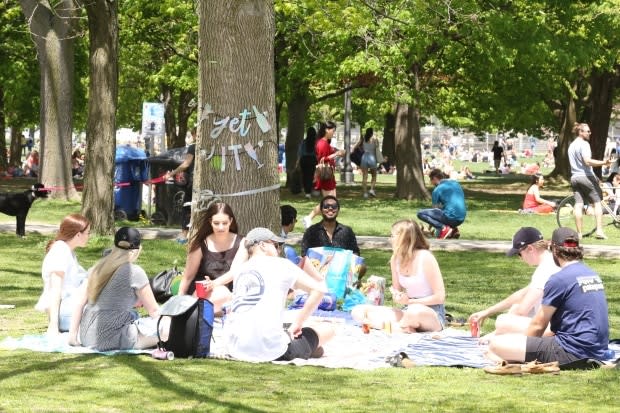If weekend crowding at Trinity Bellwoods causes a COVID-19 outbreak, how will we trace it?

Pictures and videos showing crowds of people gathered at Trinity Bellwoods Park on Saturday had one public health professor and her colleagues "really quite shocked and really quite worried" — and experts say if a COVID-19 case stems from the gathering, it could pose a big challenge for contact tracers.
"We do think that this creates a great risk that we're going to see further increase in the pre-existing uptake of new cases," said Susan Bondy, an associate professor at the University of Toronto's Dalla Lana School of Public Health.
The images showed groups of people close together, talking and laughing, a combination Bondy said "is a risk for the propagation of the epidemic."
But with the thousands of people gathered in the park Saturday, if one of them does test positive how would officials go about tracing the possible exposure?
First, all of the patients' close contacts would be identified, tested (thanks to newly expanded guidelines) and told to self isolate for 14 days.
In the case of Saturday's gathering, identifying all the possible contacts of someone would be difficult. If a positive case emerges from it, officials may have to put out a public notification telling everyone at the park that day to get tested.
"This happened over and over in waves during SARS. Media broadcasts would say, 'If you passed through North York General between this date and that date please go home and self isolate.' And that's the message that we would be relying on you the media to push out there," Bondy explained.
But in a crowd as large as the one on Saturday, if an outbreak were to occur identifying a link, or chain of infection, back to just one or two people would be difficult, said Bondy.
"People can probably identify a number of specific people that they ran into," she said, but "they won't be able to identify the potentially hundreds of people that they had come into contact with."
That kind of contact tracing is laborious detective work, done around the clock by public health workers and volunteers.
And it's precisely what University Health Network epidemiologist Dr. Lauren Lapointe-Shaw said needs to be done.
"Contact tracing is going to be the most important thing to double down on," Lapointe-Shaw pointed out, adding "minutes are of the essence ... because the more time passes the more we know there's going to be this mushrooming of cases."

How does contact tracing work?
The first step of contact tracing is to have a confirmed case of COVID-19. Once that person is identified, public health employees go about finding out where they have been in the last 14 days to understand where they picked up the virus.
More than half of the cases in Toronto are from close contacts easily identifiable to the sick person. The others are community spread, which means piecing together the story of someone's whereabouts.
"It can be quite challenging," said Toronto's Associate Medical Officer of Health Dr. Vinita Dubey.
"I mean, can you remember what you did five days ago? How can we jog your memory?" Dubey explained it might mean having to go check your emails or credit-card statements.
"[We need] to be able to piece it all together so we can collect as much info as we can — sometimes the list can be quite long," she said.

Public health employees do most of this work on the phone, speaking with the patient and their contacts. Sometimes it takes multiple follow-up calls to piece it all together.
Right now, Toronto Public Health has 550 contact tracers with another 200 expected to come on board soon. There's also a public health hotline available from 8 a.m. to 8 p.m., or 311, which is available around the clock.
But until a positive case is identified from that day at Trinity Bellwoods, Premier Doug Ford is asking anyone who was there to "do us all a favour and go get tested now."
Both the city and province's top public health advisers didn't go as far as that, suggesting only that park goers self-monitor for 14 days and try to avoid contact with vulnerable people such as seniors and young children.


